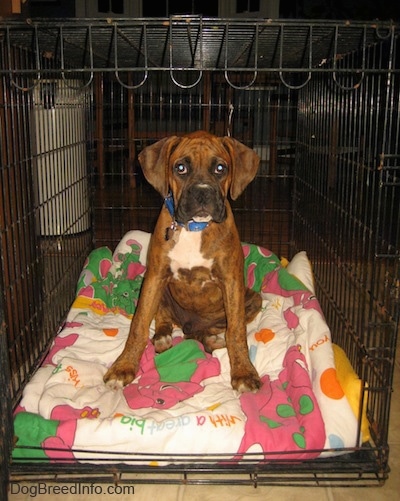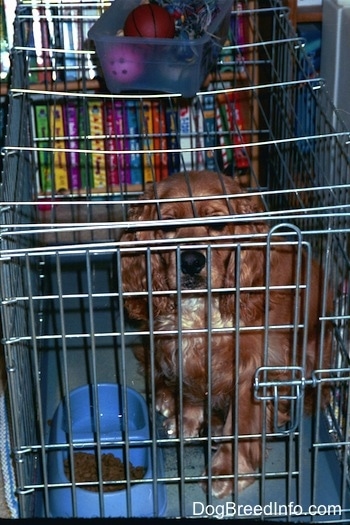
Dogs learn to love their crate as their very own special place/den. It becomes a familiar and secure place, whether in the car, at a motel or a dog show, visiting, or just at home.
Never close a crate door on a dog that is not currently relaxed. Never push a dog into the crate; get your dog to walk in on its own. Otherwise, you will create issues where the dog feels confined and trapped, seeing the crate as negative. Spend a lot of time calmly trying to associate the crate with a good thing. Just how you do that will depend on the dog and what works. Perhaps let the dog eat in the crate or give it a bone or toy to play with inside the crate with the door open. Spend time with the door open making the crate into something positive. Never close the door until the dog is relaxed and comfortable. This is a general crate rule that applies to both puppies and adult dogs, not just when in training, but every single time you put a dog in a crate. Crates should never be used as punishment. Time-out's do not work on dogs.
Crates should be large enough for the adult dog to stand, sit and stretch out. (Ideally for a puppy, you start with a smaller crate, or block off one end, so he can't use one end for sleeping and the other for eliminating.) A key principle is to teach you don't mess where you sleep and eat.

Dogs that have been kept in one big pen are harder to housetrain, simply because they've been forced to soil their living/sleeping quarters. Place the crate in an area so he is with you, and part of family activities, even as an observer. Do not put him in the basement. Place the crate in the kitchen or family room—if possible move it around with you.
If possible, at night the crate should go in your bedroom. Not only does this provide comfort to the puppy, but your own sleeping patterns will encourage the pup to slumber on and form instinct. If there is any fussing, you're there to deal with it.
I will never take a pup out of a crate when he is fussing, as that only teaches if he fusses enough, then he can come out. It rewards bad behavior. I wait till he stops fussing for about five minutes, and then take him out without a big welcome. You can give him a special chew toy or treat just for when he is in the crate. Be sure to give lots of praise when he's inside, lengthening the periods you leave him in. Your crate routine should begin as soon as you bring your puppy home. Close the puppy in the crate at regular one-to-two-hour intervals, and whenever he must be left alone, for up to three or four hours.

Remember, putting your dog into a crate does not of itself housetrain a dog. Hopefully he has already been paper trained by the breeder, and knows not to soil his living quarters. To be successful, you want to prevent your puppy from making mistakes. Many people punish a dog like mad for messing in the house, and then virtually ignore the good behavior when they eliminate outside. So you get a dog that learns it is wrong to mess in the house when the owner is present. Never clean up a mess when the puppy is watching.
To prevent mistakes, don't let your pup have the run of the house. He needs 100% active supervision. If you must leave the room, even for a phone call, crate him or take him with you.

Pookie the 4-pound longhaired Chihuahua CAUGHT peeing on the carpet! Pookie squatted and peed just a few drops. In a matter of seconds the pee soaked into the carpet. Had no one been looking at that exact moment the incident would have gone unnoticed.
The real reason for crate training, besides preventing problems, is to help you predict when the pup will need to eliminate, so you can take him to the correct spot. The first step is to start a regular feeding schedule. Confine him after eating for 10 to 15 minutes, and then take him to the elimination spot. I say, "Go pee." They do understand, and will learn to pee on command. PRAISE him after he eliminates.
Then take him back in and play with him, or if he likes it outside, play with him outside, or take him for a walk (after third set of shots). If he REALLY likes it outside, and you continually take him inside after eliminating, he will learn to HOLD it to extend his outside time. If you plan to take him for a walk, then he should do his eliminating at home, before you go. Many people take their pups for a walk, and as soon as they eliminate, they bring the dog home, thus sending the message that they are going home because the dog eliminated. If you want to start your walk right away, do not turn around and head home as soon as he poops.
After a half hour of play, crate him for a nap. Every hour (or so as he ages) take him out to pee. If he pees, give him play time, if not, back into crate. Just remember prevention of mistakes, and rewarding for good behavior.
6 weeks—elimination every hour
2 months—pup should have 2 to 3 hours of control
3 months—4 hours
4 months and up—5 hours
Many young dogs can go all night at 3 months.
Always take the puppy out the same door, the one you are going to want him to signal at. Bells work great for some owners. Hang bells on the door, and give them a kick every time you open the door. Some dogs can be quiet, and stand at the door and look at it, some will let out a little yip, but others rely on you to see them standing at the door. So bells can be a marvelous tool. They will learn to swat them to get the door to open. Others use doggy doors. But a young pup can never be sent out to pee, he must be taken out.
Courtesy of MistyTrails Havanese© Dog Breed Info Center® All Rights Reserved